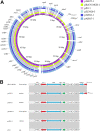Complete Genetic Analysis of Plasmids Carrying mcr-1 and Other Resistance Genes in Avian Pathogenic Escherichia coli Isolates from Diseased Chickens in Anhui Province in China
- PMID: 33853876
- PMCID: PMC8546713
- DOI: 10.1128/mSphere.01135-20
Complete Genetic Analysis of Plasmids Carrying mcr-1 and Other Resistance Genes in Avian Pathogenic Escherichia coli Isolates from Diseased Chickens in Anhui Province in China
Abstract
Antimicrobial resistance associated with colistin has emerged as a significant concern worldwide, threatening the use of one of the most important antimicrobials for treating human disease. This study aimed to investigate the prevalence of colistin-resistant avian-pathogenic Escherichia coli (APEC) and shed light on the possibility of transmission of mcr-1 (mobilized colistin resistance)-positive APEC. A total of 72 APEC isolates from Anhui Province in China were collected between March 2017 and December 2018 and screened for the mcr-1 gene. Antimicrobial susceptibility testing was performed using the broth dilution method. Pulsed-field gel electrophoresis, Southern blot analysis, and conjugation assay were performed to determine the location and conjugative ability of the mcr-1 gene. Whole-genome sequencing and analysis were performed using Illumina MiSeq and Nanopore MinION platforms. Three APEC isolates (AH25, AH62, and AH65) were found to be positive for the mcr-1 gene and showed multidrug resistance. The mcr-1 genes were located on IncI2 plasmids, and conjugation assays revealed that these plasmids were transferrable. Notably, strains AH62 and AH65, both belonging to ST1788, were collected from different places but carried the same drug resistance genes and shared highly similar plasmids. This study highlights the potential for a possible epidemic of mcr-1-positive APEC and the urgent need for continuous active monitoring.IMPORTANCE In this study, three plasmids carrying mcr-1 were isolated and characterized from APEC isolates from Anhui Province in China. The mcr-1 genes were located on IncI2 plasmids, and these plasmids were transferrable. These three IncI2 plasmids had high homology with the plasmids harbored by pathogenic bacteria isolated from other species. This finding showed that IncI2 plasmids poses a risk for the exchange of genetic material between different niches. Although colistin has been banned for use in food-producing animals in China, the coexistence of the broad-spectrum β-lactamase and mcr-1 genes on a plasmid can also lead to the stable existence of mcr-1 genes. The findings illustrated the need to improve the monitoring of drug resistance in poultry systems so as to curb the transmission or persistence of multidrug-resistant bacteria.
Keywords: APEC; IncI2; colistin resistance; mcr-1; plasmids.
Copyright © 2021 Yin et al.
Figures


Similar articles
-
Acquisition of mcr-1 and Cocarriage of Virulence Genes in Avian Pathogenic Escherichia coli Isolates from Municipal Wastewater Influents in Japan.Appl Environ Microbiol. 2019 Oct 30;85(22):e01661-19. doi: 10.1128/AEM.01661-19. Print 2019 Nov 15. Appl Environ Microbiol. 2019. PMID: 31492666 Free PMC article.
-
Emergence and Comparative Genomics Analysis of Extended-Spectrum-β-Lactamase-Producing Escherichia coli Carrying mcr-1 in Fennec Fox Imported from Sudan to China.mSphere. 2019 Nov 20;4(6):e00732-19. doi: 10.1128/mSphere.00732-19. mSphere. 2019. PMID: 31748247 Free PMC article.
-
Identification and Genomic Analyses of a Multidrug Resistant Avian Pathogenic Escherichia coli Coharboring mcr-1, bla TEM-176 and bla CTX-M-14 Genes.Transbound Emerg Dis. 2024 Feb 16;2024:9332418. doi: 10.1155/2024/9332418. eCollection 2024. Transbound Emerg Dis. 2024. PMID: 40303132 Free PMC article.
-
Prevalence and genomic characterization of clinical Escherichia coli strains that harbor the plasmid-borne tet(X4) gene in China.Microbiol Res. 2024 Aug;285:127730. doi: 10.1016/j.micres.2024.127730. Epub 2024 Apr 16. Microbiol Res. 2024. PMID: 38805981 Review.
-
Plasmid-mediated colistin-resistance genes: mcr.Trends Microbiol. 2024 Apr;32(4):365-378. doi: 10.1016/j.tim.2023.10.006. Epub 2023 Nov 25. Trends Microbiol. 2024. PMID: 38008597 Review.
Cited by
-
Colistin Resistant mcr Genes Prevalence in Livestock Animals (Swine, Bovine, Poultry) from a Multinational Perspective. A Systematic Review.Vet Sci. 2021 Nov 4;8(11):265. doi: 10.3390/vetsci8110265. Vet Sci. 2021. PMID: 34822638 Free PMC article. Review.
-
Antimicrobial resistance surveillance of Escherichia coli from chickens in the Qinghai Plateau of China.Front Microbiol. 2022 Jul 22;13:885132. doi: 10.3389/fmicb.2022.885132. eCollection 2022. Front Microbiol. 2022. PMID: 35935206 Free PMC article.
-
Identification of plasmids in avian-associated Escherichia coli using nanopore and illumina sequencing.BMC Genomics. 2023 Nov 21;24(1):698. doi: 10.1186/s12864-023-09784-6. BMC Genomics. 2023. PMID: 37990161 Free PMC article.
-
Farm to table: colistin resistance hitchhiking through food.Arch Microbiol. 2023 Apr 4;205(5):167. doi: 10.1007/s00203-023-03476-1. Arch Microbiol. 2023. PMID: 37014461 Review.
References
-
- Liu Y-Y, Wang Y, Walsh TR, Yi L-X, Zhang R, Spencer J, Doi Y, Tian G, Dong B, Huang X, Yu L-F, Gu D, Ren H, Chen X, Lv L, He D, Zhou H, Liang Z, Liu J-H, Shen J. 2016. Emergence of plasmid-mediated colistin resistance mechanism MCR-1 in animals and human beings in China: a microbiological and molecular biological study. Lancet Infect Dis 16:161–168. doi:10.1016/S1473-3099(15)00424-7. - DOI - PubMed
-
- Wang Y, Tian G-B, Zhang R, Shen Y, Tyrrell JM, Huang X, Zhou H, Lei L, Li H-Y, Doi Y, Fang Y, Ren H, Zhong L-L, Shen Z, Zeng K-J, Wang S, Liu J-H, Wu C, Walsh TR, Shen J. 2017. Prevalence, risk factors, outcomes, and molecular epidemiology of mcr-1-positive Enterobacteriaceae in patients and healthy adults from China: an epidemiological and clinical study. Lancet Infect Dis 17:390–399. doi:10.1016/S1473-3099(16)30527-8. - DOI - PubMed
Publication types
MeSH terms
Substances
LinkOut - more resources
Full Text Sources
Other Literature Sources
Medical
